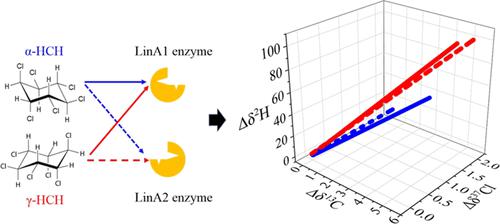当前位置:
X-MOL 学术
›
Environ. Sci. Technol.
›
论文详情
Our official English website, www.x-mol.net, welcomes your feedback! (Note: you will need to create a separate account there.)
Characterization of Hexachlorocyclohexane Isomer Dehydrochlorination by LinA1 and LinA2 Using Multi-element Compound-Specific Stable Isotope Analysis
Environmental Science & Technology ( IF 11.4 ) Pub Date : 2022-11-17 , DOI: 10.1021/acs.est.2c05334 Yaqing Liu 1 , Juan Fu 1 , Langping Wu 2, 3 , Steffen Kümmel 2 , Ivonne Nijenhuis 2 , Hans H Richnow 2, 4
Environmental Science & Technology ( IF 11.4 ) Pub Date : 2022-11-17 , DOI: 10.1021/acs.est.2c05334 Yaqing Liu 1 , Juan Fu 1 , Langping Wu 2, 3 , Steffen Kümmel 2 , Ivonne Nijenhuis 2 , Hans H Richnow 2, 4
Affiliation

|
Dehydrochlorination is one of the main (thus far discovered) processes for aerobic microbial transformation of hexachlorocyclohexane (HCH) which is mainly catalyzed by LinA enzymes. In order to gain a better understanding of the reaction mechanisms, multi-element compound-specific stable isotope analysis was applied for evaluating α- and γ-HCH transformations catalyzed by LinA1 and LinA2 enzymes. The isotopic fractionation (εE) values for particular elements of (+)α-HCH (εC = −10.8 ± 1.0‰, εCl = −4.2 ± 0.5‰, εH = −154 ± 16‰) were distinct from the values for (−)α-HCH (εC = −4.1 ± 0.7‰, εCl = −1.6 ± 0.2‰, εH = −68 ± 10‰), whereas the dual-isotope fractionation patterns were almost identical for both enantiomers (ΛC–Cl = 2.4 ± 0.4 and 2.5 ± 0.2, ΛH–C = 12.9 ± 2.4 and 14.9 ± 1.1). The εE of γ-HCH transformation by LinA1 and LinA2 were −7.8 ± 1.0‰ and −7.5 ± 0.8‰ (εC), −2.7 ± 0.3‰ and −2.5 ± 0.4‰ (εCl), −170 ± 25‰ and −150 ± 13‰ (εH), respectively. Similar ΛC–Cl values (2.7 ± 0.2 and 2.9 ± 0.2) were observed as well as similar ΛH–C values (20.1 ± 2.0 and 18.4 ± 1.9), indicating a similar reaction mechanism by both enzymes during γ-HCH transformation. This is the first data set on 3D isotope fractionation of α- and γ-HCH enzymatic dehydrochlorination, which gave a more precise characterization of the bond cleavages, highlighting the potential of multi-element compound-specific stable isotope analysis to characterize different transformation processes (e.g., dehydrochlorination and reductive dehalogenation).
中文翻译:

使用多元素化合物特异性稳定同位素分析法表征 LinA1 和 LinA2 对六氯环己烷异构体脱氯化氢的表征
脱氯化氢是六氯环己烷 (HCH) 好氧微生物转化的主要(迄今为止发现的)过程之一,主要由 LinA 酶催化。为了更好地了解反应机制,应用多元素化合物特异性稳定同位素分析来评估 LinA1 和 LinA2 酶催化的 α- 和 γ-HCH 转化。(+)α-HCH 特定元素的同位素分馏 (ε E ) 值(ε C = −10.8 ± 1.0‰,ε Cl = −4.2 ± 0.5‰,ε H = −154 ± 16‰)与(−)α-HCH 的值(ε C = −4.1 ± 0.7‰,ε Cl = −1.6 ± 0.2‰,ε H= −68 ± 10‰),而两种对映体的双同位素分馏模式几乎相同(Λ C–Cl = 2.4 ± 0.4 和 2.5 ± 0.2,Λ H–C = 12.9 ± 2.4 和 14.9 ± 1.1)。LinA1 和 LinA2 对 γ-HCH 转化的 ε E分别为 -7.8 ± 1.0‰ 和 -7.5 ± 0.8‰ (ε C )、-2.7 ± 0.3‰ 和 -2.5 ± 0.4‰ (ε Cl )、-170 ± 25‰和 −150 ± 13‰ (ε H ),分别为。观察到类似的 Λ C–Cl值(2.7 ± 0.2 和 2.9 ± 0.2)以及类似的 Λ H–C值(20.1 ± 2.0 和 18.4 ± 1.9),表明在 γ-HCH 转化过程中两种酶的反应机制相似。这是关于 α- 和 γ-HCH 酶促脱氯化氢的 3D 同位素分馏的第一个数据集,它对键断裂进行了更精确的表征,突出了多元素化合物特异性稳定同位素分析表征不同转化过程的潜力(例如,脱氯化氢和还原脱卤)。
更新日期:2022-11-17
中文翻译:

使用多元素化合物特异性稳定同位素分析法表征 LinA1 和 LinA2 对六氯环己烷异构体脱氯化氢的表征
脱氯化氢是六氯环己烷 (HCH) 好氧微生物转化的主要(迄今为止发现的)过程之一,主要由 LinA 酶催化。为了更好地了解反应机制,应用多元素化合物特异性稳定同位素分析来评估 LinA1 和 LinA2 酶催化的 α- 和 γ-HCH 转化。(+)α-HCH 特定元素的同位素分馏 (ε E ) 值(ε C = −10.8 ± 1.0‰,ε Cl = −4.2 ± 0.5‰,ε H = −154 ± 16‰)与(−)α-HCH 的值(ε C = −4.1 ± 0.7‰,ε Cl = −1.6 ± 0.2‰,ε H= −68 ± 10‰),而两种对映体的双同位素分馏模式几乎相同(Λ C–Cl = 2.4 ± 0.4 和 2.5 ± 0.2,Λ H–C = 12.9 ± 2.4 和 14.9 ± 1.1)。LinA1 和 LinA2 对 γ-HCH 转化的 ε E分别为 -7.8 ± 1.0‰ 和 -7.5 ± 0.8‰ (ε C )、-2.7 ± 0.3‰ 和 -2.5 ± 0.4‰ (ε Cl )、-170 ± 25‰和 −150 ± 13‰ (ε H ),分别为。观察到类似的 Λ C–Cl值(2.7 ± 0.2 和 2.9 ± 0.2)以及类似的 Λ H–C值(20.1 ± 2.0 和 18.4 ± 1.9),表明在 γ-HCH 转化过程中两种酶的反应机制相似。这是关于 α- 和 γ-HCH 酶促脱氯化氢的 3D 同位素分馏的第一个数据集,它对键断裂进行了更精确的表征,突出了多元素化合物特异性稳定同位素分析表征不同转化过程的潜力(例如,脱氯化氢和还原脱卤)。


























 京公网安备 11010802027423号
京公网安备 11010802027423号